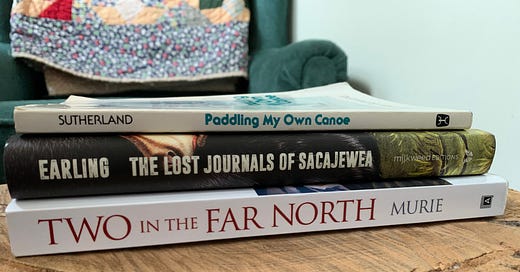Three Adventure Books That Changed the Way I Think
Inspired by my favorite new holiday tradition, our Dec. 24 family book exchange.
My favorite holiday tradition since starting my own family has been our Christmas Eve book exchange. I first got the idea from our friend, artist, writer and fellow cold-water enthusiast Anna Brones, who wrote about the Icelandic tradition of Jólabókaflóð, otherwise known as the “Christmas book flood.” The heart of the idea is to exchange books on December 24 and spend a quiet evening reading them. Dreamy enough, right?
One of the books Brendan gave me last year combined adventure and history and deconstructed some of the mythology of the West that has lived in my mind. It reshaped the way I see the world, which to me is a marker of a powerful book. So in the spirit of giving books, I thought I’d share a couple more that have affected the way I think—both about adventure and life itself. Hope you enjoy!
Paddling My Own Canoe by Audrey Sutherland
Imagine spectacular Hawaiian sea cliffs and remote waterfalls inaccessible by vehicle—only seen by airplane. Now imagine swimming through rough ocean waves, towing camping gear in a floating cooler, in order to reach them. Oh—and doing it alone. Audrey Sutherland, a single mom who worked as a teacher at the time, is famous for her solo adventures and her 1978 book Paddling My Own Canoe is a manifesto of reconnaissance, preparation and bold adventure. For me, it was my introduction to Sutherland. Combined with her book Paddling North, about her 850-mile solo kayak journey in Alaska at age 60, it has challenged my notions of what true adventure requires. I may never do a trip of that scale, but Sutherland’s ethos has become one of those consistent voices in my brain, reminding me that most excuses I make not to do something are just that: excuses. Her motto was, “go simple, go solo, go now.”
The Lost Journals of Sacajewea by Debra Magpie Earling
This is a novel, based on what’s known and theorized about Sacajewea’s journey as the only woman on Meriwether Lewis and William Clark’s 1804-1806 Corps of Discovery expedition. I’ll warn you, it isn’t an easy book. Earling, who is Bitterroot Salish, writes in a voice with a wider range of expression than our modern brains are used to. It’s poetic and sometimes difficult to read. (Not to mention the subject matter isn’t always rosy.) But once I got into the rhythm of the voice, the book became enlightening. The language felt like a window into a more holistic pre-colonial way of thinking and perceiving the world. Sometimes, on the banks of the Clark Fork River (named so for the same William Clark), Earling’s story comes back to me, and the landscape comes alive with all the haunting history it holds. The Lost Journals of Sacajewea is very much a survival story, and not the typical “man versus nature” narrative.
Two In The Far North by Margaret E. Murie
I read Two In the Far North when I was debating whether I wanted to have a kid. Murie’s stories definitely influenced my perception of what an adventurous life could look like as a mother. Known as a grandmother of the conservation movement, Murie was instrumental in passing the Wilderness Act and creating the Arctic National Wildlife Refuge. Two In the Far North tells of her marriage to ecologist Olaus Murie, and their early expeditions studing caribou in Alaska. Murie is a relentlessly positive adventurer, always seeing the bright side of things, and it leaves you with such a pleasant feeling. Those expeditions had their share of discomfort, but Murie turns it all to merriment. The couple took their toddler son along on the Arctic tundra, too. When car camping with a two-year-old feels overwhelming, take that for a little inspiration. Not to mention all the native people who’ve been raising their families in that environment for millennia. The takeaway? Just throw the tent and sleeping bags in the car and do it—a sunny disposition goes a long way.





Which was the one that reshaped the way you see the world?